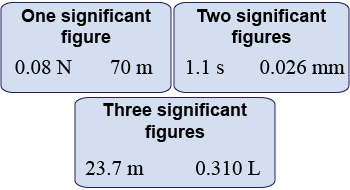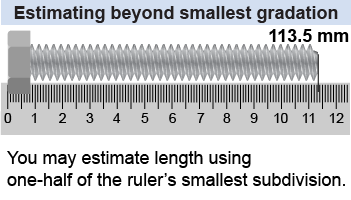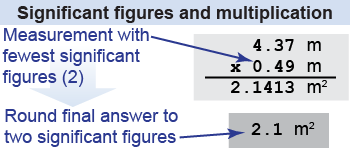|

The number of significant figures (or digits) is a code that tells you the precision of a measurement. Count the number of significant figures starting from the left-most nonzero digit. - Include zeros to the right of the decimal.
- Don’t include zeros to the left of the decimal.
A force of 0.08 N has one significant figure, a time interval of 1.1 s has two significant figures, while a volume of 0.310 L has three significant figures. |

|

| Significant figures are not the same as decimal places. The length of the bolt in the diagram is measured with a meter stick to be 113.5 mm. This is the same as 11.35 cm or 0.1135 m. Each value has four significant figures even though they differ in digits to the right of the decimal point. The last digit (5) is the most uncertain because it was estimated by reading between the millimeter marks for 113 and 114. The bolt’s true length could be anything between 113.25 and 113.75 mm. |

|
 A value that is the result of a calculation has the same number of significant figures as the least precise value (fewest significant figures) used in the calculation. In the example shown here, 4.37 m has three significant figures and is multiplied by 0.49 m, which has only two significant figures. The final answer is rounded off to two significant figures, or 2.1 m2. This rule is suspended when the result will be part of another calculation. For intermediate results, one extra significant figure should be carried to minimize rounding errors in subsequent calculations. For this example, 2.14 would be used as the value to enter into the next calculation.
A value that is the result of a calculation has the same number of significant figures as the least precise value (fewest significant figures) used in the calculation. In the example shown here, 4.37 m has three significant figures and is multiplied by 0.49 m, which has only two significant figures. The final answer is rounded off to two significant figures, or 2.1 m2. This rule is suspended when the result will be part of another calculation. For intermediate results, one extra significant figure should be carried to minimize rounding errors in subsequent calculations. For this example, 2.14 would be used as the value to enter into the next calculation. 
|
How many significant figures are in the value 216,500 m? There could be four, five, or six, depending on whether each of the last two zeros is a significant figure. Zeros to the left of the decimal may or may not be significant. Scientists solve this ambiguity by either quoting the uncertainty directly, such as ±0.1 m, or by using scientific notation. The same measurement written 2.1650×105 m tells you there are five significant figures. When a measured value is properly expressed using scientific notation, every digit that appears is a significant digit. 
|
To measure the mass of a book, you might make a direct measurement by placing it on a scale and reading out the value in kilograms. But how do you measure the mass of a grain of rice? One approach would be to measure the mass of, say, 100 grains of rice and divide the result by 100. This is called an indirect measurement. Throughout all the sciences you may make both kinds of measurement, direct and indirect. 
|
Minoo measured the mass of a marble to be 3.60 g and its volume to be 0.5235 cm3. What is the density of the marble?
 |
The density is given by the equation m/V, so using the values gives Since this is a division problem, the final answer must be expressed using the fewest number of significant figures. The mass is known to only three significant figures, even though the volume is known to four. So the final answer is rounded to three significant figures, or 6.88 g cm−3. 
|

